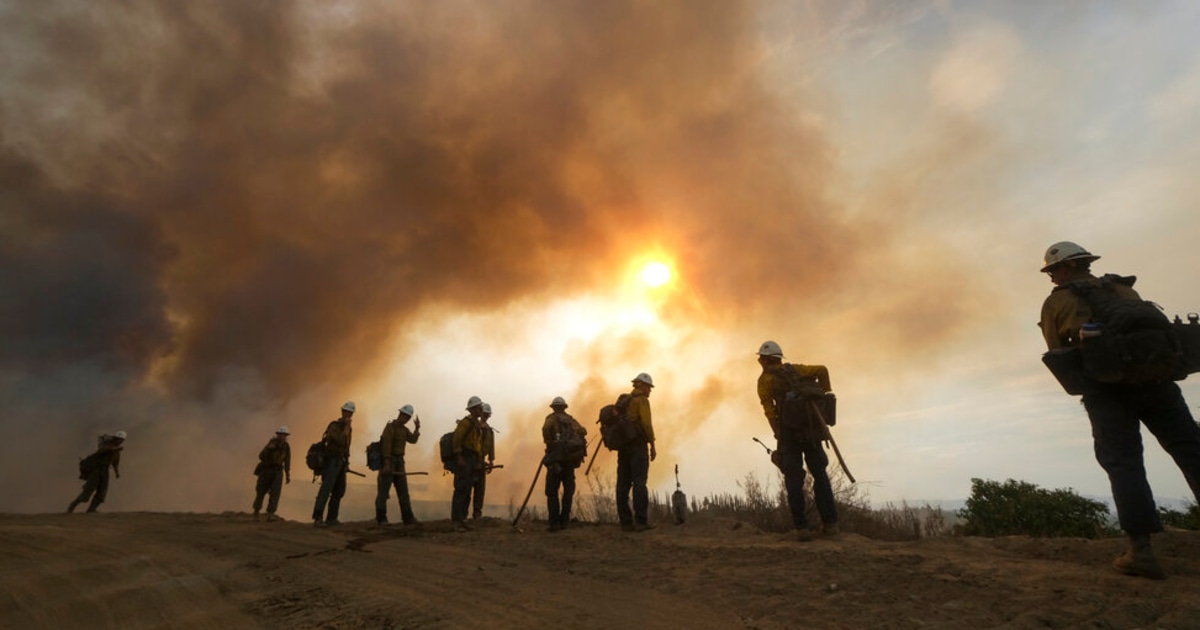By Dorany Pineda -
The Associated Press
Extreme heat and smoke from wildfires are harmful to the human body on their own, but when combined, their impact on the cardiovascular and respiratory systems is more dangerous, affecting some communities more than others.
A study published Friday in the journal
Science Advances
states that climate change is increasing the frequency of both hazards, especially in California.
The authors found that the combined damage of extreme heat and smoke inhalation caused by wildfires
increased hospitalizations
, disproportionately affecting low-income communities and Latino, Black, Asian, and other racially marginalized residents.
Firefighters watch flames on a hill near Hemet, California, on Sept. 8, 2022. Associated Press
The reasons are varied and complicated, according to the authors, from the Scripps Institution of Oceanography at the University of California, San Diego, and the Fielding School of Public Health at UCLA.
Structural racism, discriminatory practices, lack of health insurance, lower awareness of health harms, and higher prevalence of multiple co-occurring conditions are some of the reasons.
Infrastructure, the environment and available resources also influence.
Air-conditioned homes and workplaces and neighborhoods with trees are better protected from extreme heat.
Some buildings filter wildfire smoke and insulate heat more efficiently.
Areas with access to air-conditioned facilities, such as libraries, also offer more protection.
[Planet Earth: The climate emergency affects the greatest engineering work of the 20th century... and world trade]
"Even if you are very susceptible - you suffer from several diseases - you may have a good chance of not being impacted, of not being hospitalized, of not having to go to the emergency room, but if you live in a fairly remote place that doesn't have access to many services [...] amenities, that may be more problematic," said Tarik Benmarhnia, study author and climate change epidemiologist at UC San Diego.
Experts warn that climate change – which is worsening extreme weather events such as droughts, heat waves and forest fires – will increase the frequency and intensity with which they occur simultaneously.
Although the study focused on California, similar patterns can be found in other areas of the western United States, such as Oregon and Washington state, in parts of Canada, including British Columbia, and in regions with a Mediterranean climate, Benmarhnia explained.
[Planet Earth: Peru has lost almost 60% of its glaciers in six decades]
Researchers analyzed California health records – broken down by 995 ZIP codes covering most of the state's population – during episodes of extreme heat and toxic air due to wildfires.
They found that between 2006 and 2019, hospitalizations for cardiorespiratory problems
increased 7% on days when both conditions occurred
, and were highest in ZIP codes where people were more likely to be poor, non-white, live in dense areas and had no medical care.
Higher incidences of both heat and wildfires were reported in California's Central Valley and the state's northern mountains, likely due to the greater number of fires in the surrounding mountains.
According to Benmarhnia, residents in the agricultural heartland of the Central Valley are especially vulnerable to the adverse health effects of both phenomena because they are more likely to work outdoors and be exposed to pesticides and other environmental hazards.
[Planet Earth: Brazilian Congress approves paving of a road in the Amazon jungle]
Beyond the health risks, hospitalization has other important consequences, such as loss of work or study hours, or having to face high medical bills.
According to Christopher T. Minson, professor of Human Physiology at the University of Oregon, who was not involved in the study, during extremely hot days the human body
has a harder time cooling itself through sweat
.
The body can become dehydrated, forcing the heart to beat faster, which raises blood pressure.
"If you are dehydrated or suffer from some type of cardiovascular disease, [...] you will be less able to tolerate that heat stress, and that heat stress can be very, very dangerous," he explained.
According to the Environmental Protection Agency, some particles in wildfire smoke can easily enter the nose and throat and eventually reach the lungs.
Smaller particles can even enter the bloodstream.
According to Minson, the combination of heat and smoke
can cause inflammation in the body
, which "will worsen cardiovascular regulation and increase the risk of heart attacks and other long-term health problems. So it's definitely a snowball effect."
A 2022 study by the University of Southern California found that the risk of death increased on days when extreme heat and air pollution coincided.
During heat waves, the probability of death increased 6.1%;
when air pollution was extreme, it rose 5%;
and on days when both were combined, the threat shot up to 21%.
When Dr. Catharina Giudice worked at a Los Angeles hospital, she saw an increase in emergency room visits from patients with various health problems on days of extreme heat.
When wildfires raged, she saw
more people with exacerbated asthma and other respiratory illnesses
.
As climate change increases the intensity and frequency of heat waves and wildfires, Giudice worries about low-income and minority communities less adapted to them.
"For a variety of reasons, they tend to feel climate change much more than other communities that are not underserved, and I think it's really important to highlight this social injustice aspect of climate change," said the emergency physician and member of the School of Health Publicizes TH Chan of Harvard, who was not involved in the study.
The authors noted that agencies such as the National Weather Service and local air quality districts issue separate advisories and warnings on days of extreme heat and toxic air.
But they assure that "issuing a joint warning earlier taking into account exposure to both would be beneficial."

